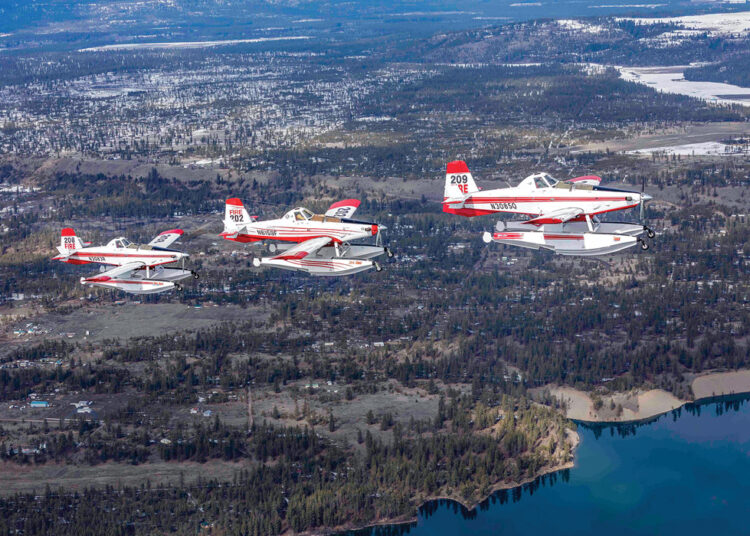A top-notch aerial firefighter isn’t a pilot – they’re a firefighter with an airplane. They know fire behavior and suppression tactics. They understand that fire is the mission and their expert piloting skills are part of what they need to help their team win the war against these threats. While fighting wildfires from the air or the ground is deeply humbling and rewarding, it requires specific skills and a lot of sacrifice.
Whether you’re a seasoned pilot looking for a transition, or a younger pilot working toward a career in aerial firefighting, here are the top things you’ll want to know, and develop, before trying to join a wildfire mission.
Experience: No pilot starts off in aerial firefighting
It takes years to build up the technical skills and experience necessary to become an aerial firefighter. Piloting backgrounds are diverse and span military, corporate and agricultural applications. As with most professions, the more diversity of experience you have, the more well-rounded of a professional you’ll be, bringing a whole host of skills to your team.
Here are examples of how typical aerial firefighting backgrounds can help you become a better firefighter with an airplane:
- Agricultural (ag) experience is paramount, and a requirement for every wheeled SEAT or Fire Boss pilot. The single-engine environment, low-level flying experience and varieties of terrain make it a must-have part of your background. In general, experience with smaller stick and rudder or tailwheel planes without automation is critical, because there’s no automation or autopilot in aerial firefighting. On top of that, the best ag pilots know what it’s like to jump in an airplane at the crack of dawn and be in it all day, performing multiple takeoffs and landings and maintaining a grueling pace without sacrificing diligence or safety.
- Military service is common among aerial firefighters, although not a requirement. A critical skill for every firefighter, military piloting teaches you how to be your best in high-intensity situations. You know what it’s like to work as part of a team, communicating effectively and working together to ensure a successful and safe mission. Perhaps just as importantly, military service teaches you what it’s like to be away from home for extended periods of time, which is a tough reality for many wildland firefighters and their families. Military service people and their families know the sacrifice it takes to beat a powerful and relentless enemy.
- Corporate or airline piloting can build away-from-home experience as well. It also gives pilots important familiarity with weather fluctuations that come with flying diverse and cross-country routes.
Traits: Aerial firefighting takes more than technical piloting skill
To succeed as an aerial firefighter, you need more than technical skill.
There are common traits that we find are almost always present in the best firefighting pilots:
- Team-first attitude: Wildfire suppression is impossible without teamwork. From the dispatchers to the ground crew to the planes overhead, every piece of a response team must be working in harmony. That means every person has a team-first attitude and understands there are no individual heroes in this profession.
- Willingness to learn: When lives are on the line, you have to always be at your best. That means committing to continuous learning and improvement. When you’re on a team like the one at Dauntless, there’s a purposeful commitment to bringing in pilots with diverse and wide-ranging backgrounds, so everyone can learn from one another and bring different piloting experiences to the table.
- Sociability/Fit: Fighting fires can be a lonely job. Usually far from home and gone for months at a time, we’ve noticed the best aerial firefighting teams are full of friendly, sociable people who spend time together outside the mission.
- Mental toughness: Aerial firefighters work tirelessly to help win the war against wildfires. Our pilots don’t back down when the mission is daunting; we push ourselves and our aircraft to safely achieve more, fly more efficiently and drop on target. Although it may sound like a cool job, it is far from easy. The sacrifices are worth it if you have a mental toughness and passion for the fire mission at hand.
What’s next: The steps you can take now to start your journey toward aerial firefighting
There are specific requirements for becoming an aerial firefighter, including minimum flight hours and specific aircraft experience. Review this list of pilot qualifications and start to work toward the minimums you may not yet have achieved.
If you’re already fully qualified – or not – start having conversations with aerial firefighters in your community or around the nation. Talk to them about their experience with the challenges and rewards that come with fighting fires.
For more information or if you want to take the next step in an Aerial Firefighting career, contact the author of the story, Dauntless Aviation Here






